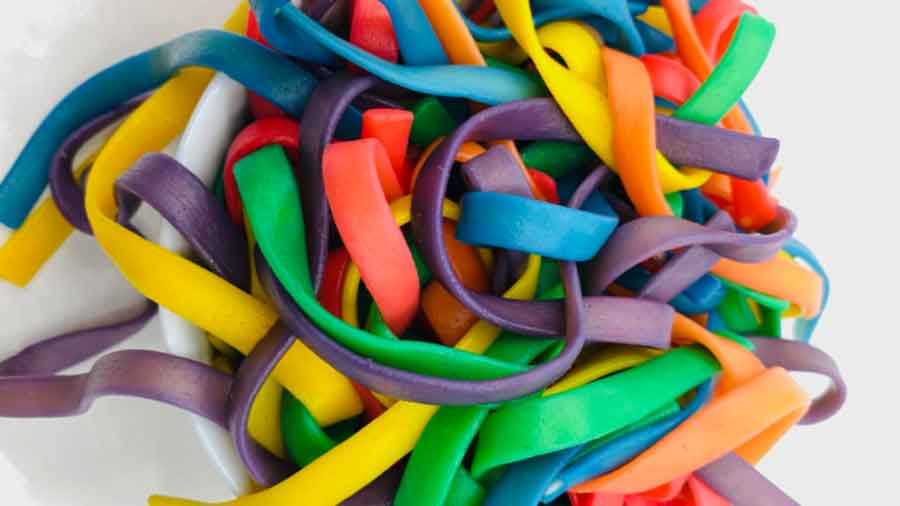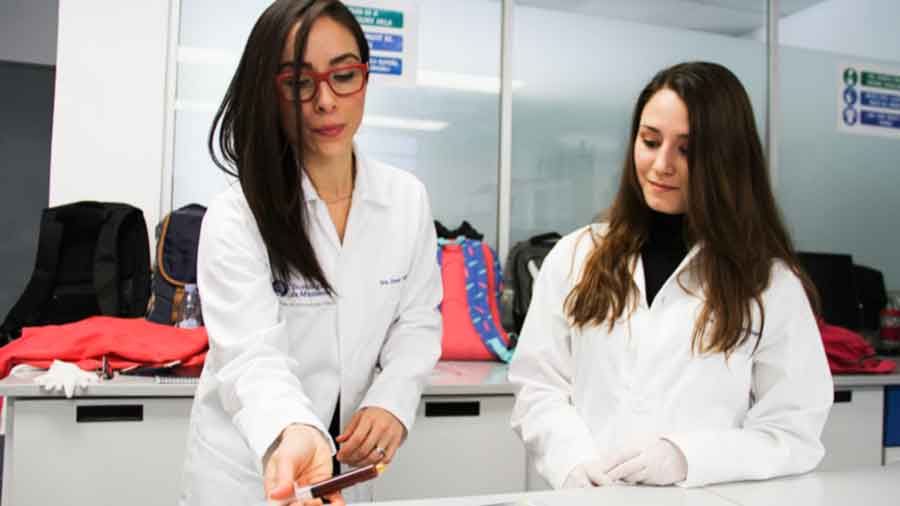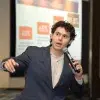Dr. Grissel Trujillo, a Mexican researcher at Tec de Monterrey, was the winner of the cover design for the scientific journal Material Advances, published by the Royal Society of Chemistry, a scientific society in the United Kingdom.
Grissel told CONECTA that she was given the chance to design the cover of the July 2021 issue, after it included a scientific review led by her on the subject of synthetic polymers.
“It’s a review, which is like a synopsis or a critical analysis on a certain topic. In this case, it’s a review of synthetic polymers that have been used in biomedical applications which focuses on tissue engineering,” explains the Tec research professor.
The authors of the article were eleven expert researchers from Tec de Monterrey, Harvard University in the United States, and the University of Naples in Italy.

How she designed the cover in her own kitchen
Journal editor Elizabeth Cosgriff invited Grissel to design the cover after she had read the review on polymers directed by the researcher.
Grissel says that the Material Advances journal is one of the newest from the Royal Society of Chemistry, so she was flattered to be chosen.
“It’s flattering that they’ve given us the cover at this point because they were just establishing the journal and they had to be very selective.
“Actually, she offered us the back cover, but then they liked it so much that they gave us the front cover,” says Trujillo, smiling.
“It’s flattering that they’ve given us the cover at this point because they’re establishing the magazine and they have to be very selective.”
The image that Grissel designed, which appears on the cover of the journal, is fetuccini colored green, red, orange, blue, purple, and yellow and intertwined in the shape of a ball to simulate a polymer, with the letters RGD in front.
“It’s an example to explain polymers that I use a lot in my biomaterials classes.
“Each strip represents a polymer molecule. The letters RGD are a triad of amino acids that molecules use to adhere to a surface. As synthetic polymers don’t have them, they’re added,” explains the researcher.

According to Trujillo, polymers mix certain properties such as being thermal or mechanical and may have some biomedical applications, such as a gel that can simulate some part of the human body or an organ, as well as other uses.
Her husband Mario Álvarez, who’s also a co-author for the same investigation and with whom she runs the Alvarez-Trujillo Lab at Tec de Monterrey, helped Grissel take a photograph of the plate with the colored pasta.
“The analogy was one of the things that drew the editor’s attention. (She asked me:) How could Grissel explain a concept as difficult as a functional polymer in a dynamic way?’
“We bought the pasta, Grissel dyed it, then put it together, and we took the photo in the kitchen. We used a photo studio that we bought on Amazon,” says Álvarez smiling.
The article on polymers that won her the cover
Both researchers explain that a scientific review aims to present relevant and current research information in an area.
The review “Engineering bioactive synthetic polymers for biomedical applications” brings together the work of researchers in the creation of synthetic polymers in foam, 3D printing, and fibers, as well as others, with biological applications.
Trujillo says that in this review, they gathered information from 315 references on the work of researchers in this area.
“It’s to give (the audience) news of the advances over the last 10 years and it’s incredibly valuable, as we’ve already reviewed the 315 articles, so they don’t have to go through them all individually.
“Someone has already made a thorough search and the information is compact and broken down. We identify the challenges for the future and the perspectives,” says Trujillo.
The researcher adds that although there were already studies on synthetic polymers that have had applications in various areas, there was no review, so Grissel overcame the challenges and created one.

The challenges of doing a scientific review
Coordinating a multidisciplinary group was one of the biggest challenges Grissel faced during the review.
“Each one (of the researchers) sees the project from a different perspective and each one may be interested in a different aspect,” she says.
Visualizing something that would be interesting to a researcher was the first step that Trujillo took in putting together the document.
“Then we established the structure within each of the sections. For example, as this has to do with biomedical applications and biomedical concepts, we had to go into those sections to give an interpretation,” she says.
The challenges of doing a scientific review
Coordinating a multidisciplinary group was one of the biggest challenges Grissel faced during the review.
“Each one (of the researchers) sees the project from a different perspective and each one may be interested in a different aspect,” she says.
Visualizing something that would be interesting to a researcher was the first step that Trujillo took in putting together the document.
“Then we established the structure within each of the sections. For example, as this has to do with biomedical applications and biomedical concepts, we had to go into those sections to give an interpretation,” she says.

Previous cover designs
This isn’t the first cover that Grissel and Mario have had as a laboratory, and it isn’t even the first that they’ve done for a Royal Society of Chemistry journal. In 2018, Mario got the cover of Material Horizons.
“This year, we’ve done very well with covers. They gave us one for a material that we developed from a corn protein for 3D printing.
“It’s important for marketing in the field of science. It’s how the editor (of a scientific journal) can show that there are important articles inside,” says Grissel.
Mario points out that as a research group, they have around nine or ten covers so far.
“At the LATAM level, there are no groups that have so many. Ten is a respectable number in the international academic community.
“It’s very important for the institution. Little by little, we’re establishing Tec de Monterrey’s name in the field of graphic art, science, and scientific marketing,” Álvarez says.
“Little by little we’re establishing the name of Tec de Monterrey in the field of graphic art, science, and scientific marketing.”
What’s more, this isn’t the first review of this type by Grissel Trujillo, as she previously published a similar one on osteogenic bioprinting that had more than 1,050 citations.
“One reference for the entire global community. With this article, we’ve just reached 1,050 citations, which is a spectacular number,” says Álvarez.
“These covers open the doors not only to us as researchers, but to our students. We want it to be a hallmark of quality,” concludes Trujillo.
READ MORE:





